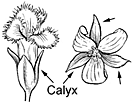Ōpuhe
Urera glabra
Nettle family (Urticaceae)
Native species ()
Medium-sized native tree on the island of Hawaii or a shrub or small tree on the other islands, with slightly milky or watery sap, elliptical wavy leaves, and very numerous tiny flowers along twigs partly back of leaves, male and female on different trees. To 35 ft (10.7 ) high, with a straight trunk 1 ft (0.3 ) in diameter and long stout branches. Bark gray, smooth, very fibrous.

©2003 Forest And Kim Starr
Flower clusters () at base of leaves or back of leaves, about 2–3 inches (5–7.5 ) in diameter, much forked regularly by two. Flowers male and female on different plants (), very numerous, without Male flowers 8–20 almost stalkless in rounded balls, each about 1⁄8 inch (3 ) in diameter, composed of pale reddish to whitish 4–5 and five Female flowers with 3–4- bordered by a cup and with and yellow
are rounded, about 1⁄8 inch (3 ) in diameter, with enlarged fleshy orange yellow enclosing one seed (), elliptical and rough, with yellow
The wood is soft and lightweight. The fibrous bark was used by the Hawaiians for fish nets and at times for their tapa cloth.
Widespread in moist forests through the islands, as a tree at 500–5500 ft (152–1676 ) altitude on the island of Hawaii and as a shrub or small tree on the other islands.
Special areas
Volcanoes, Kipuka Puaula, Wahiawa
Range
Hawaiian Islands only
Other common names
hōpue, hona
Botanical
Urea sandwicensis Wedd.
Treated here as a single variable species, though also separated as two. Another, Urera kaalae Wawra, Kaala urera, is a small tree of the Waianae Range of Oahu, with veined heart-shaped leaves, possibly or almost extinct.







